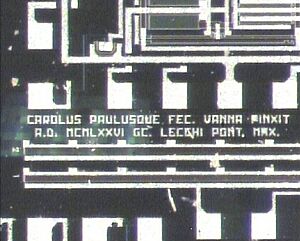Mycoplasma laboratorium facts for kids
Quick facts for kids Mycoplasma mycoides JCVI-syn1.0 |
|
|---|---|
| Scientific classification |
|
| Domain: | Bacteria |
| Phylum: | Tenericutes |
| Class: | Mollicutes |
| Order: | Mycoplasmatales |
| Family: | Mycoplasmataceae |
| Genus: | Mycoplasma |
| Species: |
M. mycoides
|
| Subspecies: |
M. m. JCVI-syn1.0
|
| Trinomial name | |
| Mycoplasma mycoides JCVI-syn1.0 Gibson et al., 2010
|
|
| Synonyms | |
|
Mycoplasma laboratorium Reich, 2000 |
|
Mycoplasma laboratorium or Synthia refers to a synthetic strain of bacterium. The project to build the new bacterium has evolved since its inception. Initially the goal was to identify a minimal set of genes that are required to sustain life and rebuild these genes synthetically to create a "new" organism. Mycoplasma genitalium was originally chosen as the basis for this project because at the time it had the smallest number of genes of all organisms analyzed. Later, the focus switched to Mycoplasma mycoides and took a more trial-and-error approach.
To identify the minimal genes required for life, each of the 482 genes of M. genitalium was individually deleted and the viability of the resulting mutants was tested. This resulted in the identification of a minimal set of 382 genes that theoretically should represent a minimal genome. In 2008 the full set of M. genitalium genes was constructed in the laboratory with watermarks added to identify the genes as synthetic. However M. genitalium grows extremely slowly and M. mycoides was chosen as the new focus to accelerate experiments aimed at determining the set of genes actually needed for growth.
In 2010, the complete genome of M. mycoides was successfully synthesized from a computer record and transplanted into an existing cell of Mycoplasma capricolum that had had its DNA removed. It is estimated that the synthetic genome used for this project cost US$40 million and 200 man-years to produce. The new bacterium was able to grow and was named JCVI-syn1.0, or Synthia. After additional experimentation to identify a smaller set of genes that could produce a functional organism, JCVI-syn3.0 was produced, containing 473 genes. 149 of these genes are of unknown function. Since the genome of JCVI-syn3.0 is novel, it is considered the first truly synthetic organism.
Contents
Minimal genome project
The production of Synthia is an effort in synthetic biology at the J. Craig Venter Institute by a team of approximately 20 scientists headed by Nobel laureate Hamilton Smith and including DNA researcher Craig Venter and microbiologist Clyde A. Hutchison III. The overall goal is to reduce a living organism to its essentials and thus understand what is required to build a new organism from scratch. The initial focus was the bacterium M. genitalium, an obligate intracellular parasite whose genome consists of 482 genes comprising 582,970 base pairs, arranged on one circular chromosome (at the time the project began, this was the smallest genome of any known natural organism that can be grown in free culture). They used transposon mutagenesis to identify genes that were not essential for the growth of the organism, resulting in a minimal set of 382 genes. This effort was known as the Minimal Genome Project.
Choice of organism
Mycoplasma
Mycoplasma is a genus of bacteria of the class Mollicutes in the division Mycoplasmatota (formerly Tenericutes), characterised by the lack of a cell wall (making it Gram negative) due to its parasitic or commensal lifestyle. In molecular biology, the genus has received much attention, both for being a notoriously difficult-to-eradicate contaminant in mammalian cell cultures (it is immune to beta-lactams and other antibiotics), and for its potential uses as a model organism due to its small genome size. The choice of genus for the Synthia project dates to 2000, when Karl Reich coined the phrase Mycoplasma laboratorium.
Other organisms with small genomes
As of 2005, Pelagibacter ubique (an α-proteobacterium of the order Rickettsiales) has the smallest known genome (1,308,759 base pairs) of any free living organism and is one of the smallest self-replicating cells known. It is possibly the most numerous bacterium in the world (perhaps 1028 individual cells) and, along with other members of the SAR11 clade, are estimated to make up between a quarter and a half of all bacterial or archaeal cells in the ocean. It was identified in 2002 by rRNA sequences and was fully sequenced in 2005. It is extremely hard to cultivate a species which does not reach a high growth density in lab culture. Several newly discovered species have fewer genes than M. genitalium, but are not free-living: many essential genes that are missing in Hodgkinia cicadicola, Sulcia muelleri, Baumannia cicadellinicola (symbionts of cicadas) and Carsonella ruddi (symbiote of hackberry petiole gall psyllid, Pachypsylla venusta) may be encoded in the host nucleus. The organism with the smallest known set of genes as of 2013 is Nasuia deltocephalinicola, an obligate symbiont. It has only 137 genes and a genome size of 112 kb.
| species name | number of genes | size (Mbp) |
|---|---|---|
| Candidatus Hodgkinia cicadicola Dsem [1] | 169 | 0.14 |
| Candidatus Carsonella ruddii PV [2] | 182 | 0.16 |
| Candidatus Sulcia muelleri GWSS [3] | 227 | 0.25 |
| Candidatus Sulcia muelleri SMDSEM [4] | 242 | 0.28 |
| Buchnera aphidicola str. Cinara cedri [5] | 357 | 0.4261 |
| Mycoplasma genitalium G37 [6] | 475 | 0.58 |
| Candidatus Phytoplasma mali [7] | 479 | 0.6 |
| Buchnera aphidicola str. Baizongia pistaciae [8] | 504 | 0.6224 |
| Nanoarchaeum equitans Kin4-M [9] | 540 | 0.49 |
Techniques
Several laboratory techniques had to be developed or adapted for the project, since it required synthesis and manipulation of very large pieces of DNA.
Bacterial genome transplantation
In 2007, Venter's team reported that they had managed to transfer the chromosome of the species Mycoplasma mycoides to Mycoplasma capricolum by:
- isolating the genome of M. mycoides: gentle lysis of cells trapped in agar—molten agar mixed with cells and left to form a gel—followed by pulse field gel electrophoresis and the band of the correct size (circular 1.25Mbp) being isolated;
- making the recipient cells of M. capricolum competent: growth in rich media followed starvation in poor media where the nucleotide starvation results in inhibition of DNA replication and change of morphology; and
- polyethylene glycol-mediated transformation of the circular chromosome to the DNA-free cells followed by selection.
The term transformation is used to refer to insertion of a vector into a bacterial cell (by electroporation or heatshock). Here, transplantation is used akin to nuclear transplantation.
Bacterial chromosome synthesis
In 2008 Venter's group described the production of a synthetic genome, a copy of M. genitalium G37 sequence L43967, by means of a hierarchical strategy:
- Synthesis → 1kbp: The genome sequence was synthesized by Blue Heron in 1,078 1080bp cassettes with 80bp overlap and NotI restriction sites (inefficient but infrequent cutter).
- Ligation → 10kbp: 109 groups of a series of 10 consecutive cassettes were ligated and cloned in E. coli on a plasmid and the correct permutation checked by sequencing.
- Multiplex PCR → 100kbp: 11 Groups of a series of 10 consecutive 10kbp assemblies (grown in yeast) were joined by multiplex PCR, using a primer pair for each 10kbp assembly.
- Isolation and recombination → secondary assemblies were isolated, joined and transformed into yeast spheroplasts without a vector sequence (present in assembly 811-900).
The genome of this 2008 result, M. genitalium JCVI-1.0, is published on GenBank as CP001621.1. It is not to be confused with the later synthetic organisms, labelled JCVI-syn, based on M. mycoides.
Synthetic genome
In 2010 Venter and colleagues created Mycoplasma mycoides strain JCVI-syn1.0 with a synthetic genome. Initially the synthetic construct did not work, so to pinpoint the error—which caused a delay of 3 months in the whole project—a series of semi-synthetic constructs were created. The cause of the failure was a single frameshift mutation in DnaA, a replication initiation factor.
The purpose of constructing a cell with a synthetic genome was to test the methodology, as a step to creating modified genomes in the future. Using a natural genome as a template minimized the potential sources of failure. Several differences are present in Mycoplasma mycoides JCVI-syn1.0 relative to the reference genome, notably an E.coli transposon IS1 (an infection from the 10kb stage) and an 85bp duplication, as well as elements required for propagation in yeast and residues from restriction sites.
There has been controversy over whether JCVI-syn1.0 is a true synthetic organism. While the genome was synthesized chemically in many pieces, it was constructed to match the parent genome closely and transplanted into the cytoplasm of a natural cell. DNA alone cannot create a viable cell: proteins and RNAs are needed to read the DNA, and lipid membranes are required to compartmentalize the DNA and cytoplasm. In JCVI-syn1.0 the two species used as donor and recipient are of the same genus, reducing potential problems of mismatches between the proteins in the host cytoplasm and the new genome. Paul Keim (a molecular geneticist at Northern Arizona University in Flagstaff) noted that "there are great challenges ahead before genetic engineers can mix, match, and fully design an organism's genome from scratch".
Watermarks

A much publicized feature of JCVI-syn1.0 is the presence of watermark sequences. The 4 watermarks (shown in Figure S1 in the supplementary material of the paper) are coded messages written into the DNA, of length 1246, 1081, 1109 and 1222 base pairs respectively. These messages did not use the standard genetic code, in which sequences of 3 DNA bases encode amino acids, but a new code invented for this purpose, which readers were challenged to solve. The content of the watermarks is as follows:
- Watermark 1: an HTML document which reads in a Web browser as text congratulating the decoder, and instructions on how to email the authors to prove the decoding.
- Watermark 2: a list of authors and a quote from James Joyce: "To live, to err, to fall, to triumph, to recreate life out of life".
- Watermark 3: more authors and a quote from Robert Oppenheimer (uncredited): "See things not as they are, but as they might be".
- Watermark 4: more authors and a quote from Richard Feynman: "What I cannot build, I cannot understand".
JCVI-syn3.0
In 2016, the Venter Institute used genes from JCVI-syn1.0 to synthesize a smaller genome they call JCVI-syn3.0, that contains 531,560 base pairs and 473 genes. In 1996, after comparing M. genitalium with another small bacterium Haemophilus influenzae, Arcady Mushegian and Eugene Koonin had proposed that there might be a common set of 256 genes which could be a minimal set of genes needed for viability. In this new organism, the number of genes can only be pared down to 473, 149 of which have functions that are completely unknown. As of 2022 the unknown set has been narrowed to about 100. In 2019 a complete computational model of all pathways in Syn3.0 cell was published, representing the first complete in silico model for a living minimal organism.
Similar projects
From 2002 to 2010, a team at the Hungarian Academy of Science created a strain of Escherichia coli called MDS42, which is now sold by Scarab Genomics of Madison, WI under the name of "Clean Genome. E.coli", where 15% of the genome of the parental strain (E. coli K-12 MG1655) were removed to aid in molecular biology efficiency, removing IS elements, pseudogenes and phages, resulting in better maintenance of plasmid-encoded toxic genes, which are often inactivated by transposons. Biochemistry and replication machinery were not altered.


